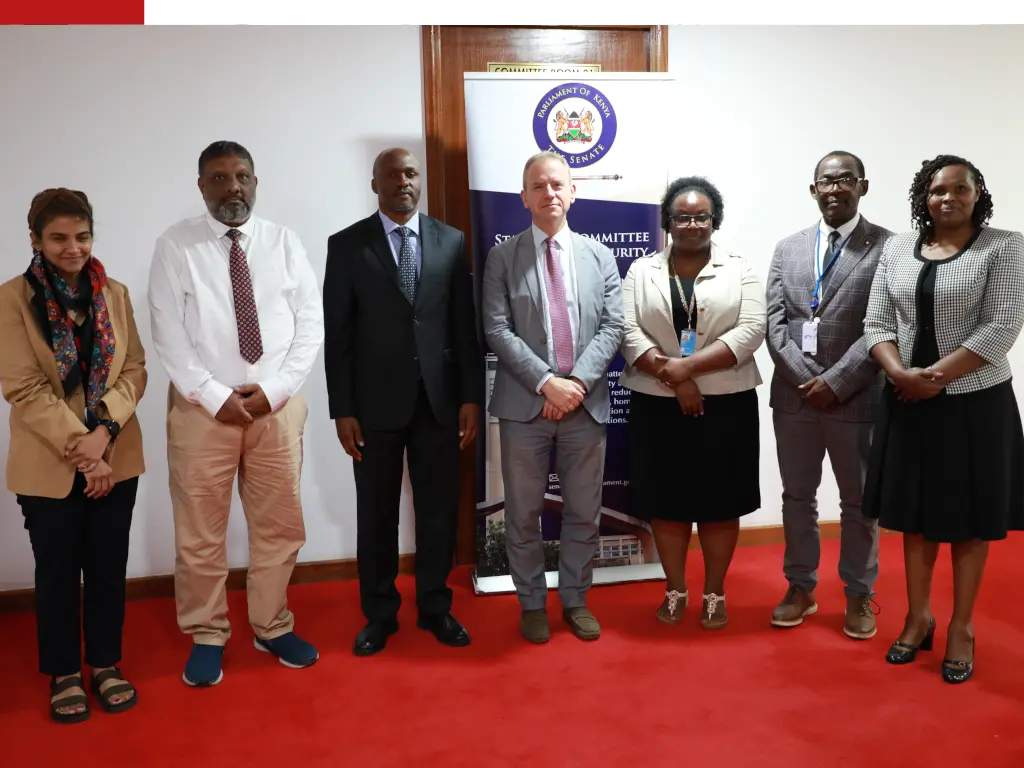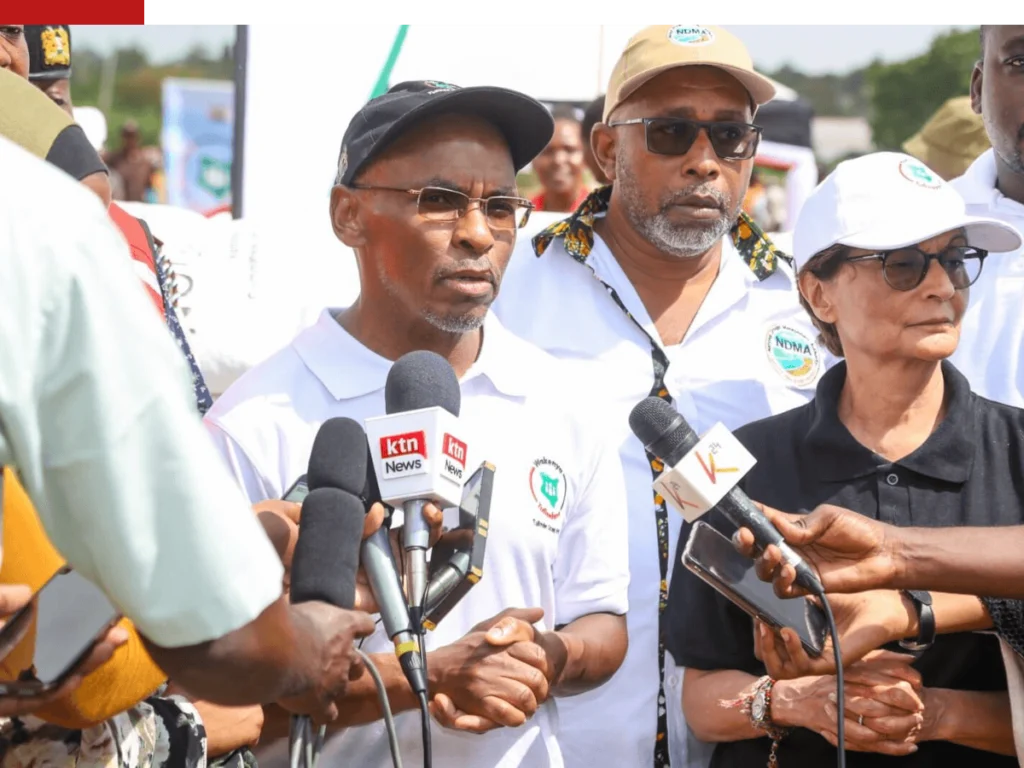Nairobi Kenya, 12/09/2024: The National Steering Committee on Disaster Response (NSCDR) was established vide Executive Order No.2 of 2024 to mobilize resources to augment the National Government’s emergency response coordination actions and efforts. The National Steering Committee’s membership is drawn from the Private Sector, Development Partners, and the Government of Kenya and has been in force since 17th May 2024.
On Thursday, the National Steering Committee on Disaster Response (NSCDR) led by Dr. Stephen Jackson UN Resident Coordinator, the Chair of the Policy and Legal subcommittee submitted a raft of recommendations to the Senate to strengthen the current bill on National Disaster Management Bill 2023, through the complete Disaster Risk Management (DRM) cycle including prevention, resilience/adaptation, early warning, and response.
NSCDR has also called for a single structure to be considered to coordinate and implement Disaster Risk Management activities in Kenya to ensure greater efficiency, coherency, and transparency.
At the same time, there’s a need to amend section 110 of the Public Finance Act to make it mandatory for the counties to ring-fence 2 percent of their budget for Disaster Risk Management. Currently, counties are spending 2 to 5 percent of their budget on emergency response.
The National Disaster Risk Management Bill 2023, therefore, is a proposed legislation that seeks to ensure an effective and timely response to any disaster and to prevent its adverse effects.
The provisions of the bill seek to establish an institutional framework on disaster risk management via the proposed National Disaster Risk Management Authority (NDRMA) and County Disaster Risk Management Committees, as well as provide a legal framework to coordinate disaster risk management response.
The 10 key recommendations by NSCDR include:
1. Greater alignment of provisions with International Frameworks:
The Sendai Framework, Paris Agreement, and the United Nations Framework Convention on Climate Change (UNFCCC)) which have been agreed by all Member States at the UN General Assembly. For example:
Guiding Principles that align with the Sendai Framework would promote further domestication of the Framework and ensure coherence between the implementation of international agreements and national legislation.
Definitions to be drawn from the Open-Ended Intergovernmental Expert Working Group on Indicators and Terminology, including “disaster”, “disaster risk management”, “disaster risk
reduction” “disaster preparedness”, and “resilience” in the Bill. These definitions could be further strengthened and made more prominent.
The complete Disaster Risk Management (DRM) cycle including prevention, resilience/adaptation, early warning, and response to be covered by the Bill.
Strengthen Government coordination at national and local levels.
Empower county, local authorities, and communities to reduce disaster risk including through resources, incentives, and decision-making responsibilities.
2. Adopt a multi-hazard approach:
A multi-hazard approach (inclusive of drought) affecting different areas of the country, would promote comprehensiveness in its overall functionality and efficiency; and acknowledge expertise and experiences at the national and county level. Such an approach would enable inclusive risk-informed decision-making.
3. Enhance emphasis on prevention, preparedness, resilience, and early warning
In addition to response functions to build a climate-smart and adaptable disaster management system:
- Strengthen focus on governance and coordination for impact-based early warning, early and anticipatory action.
- Incorporate innovative approaches by integrating climate change projections into disaster preparedness plans and promoting community-based risk reduction initiatives to leverage local knowledge and resources.
- Promote response activities that include immediate lifesaving support as well as medium to long-term responses such as relocation, social protection, livelihood restoration, and mental health support.
4. Clarify and Strengthen Institutional Architecture:
The Committee recommends establishing a single multi-hazard national-level authority (the National Disaster Risk Management Authority) to coordinate and implement the full cycle of Disaster Risk Management response. This would reduce fragmentation in its current form.
Recommendations include:
- Establish the NDRMA as a multi-hazard entity with responsibilities for all disasters including drought.
- Maintain as proposed in the Bill, the NDMU and NDOC to be subsumed within the NDRMA and consider the future status of the NDMA.
- Expand the membership and responsibility of the structures established in the Bill e.g., the Inter-Government Council, County Committees, etc. These entities would also engage in national vulnerability and risk assessments regularly.
- Establish empowered county committees with adequate decision-making authority during disasters, which are coordinated by the NDRMA nationally.
However, given existing legislative, financial, and institutional arrangements and priorities, in particular the expertise of specialized entities such as the National Drought Management Authority, the Steering committee recommends, in the short-term, enhancing the emphasis on NDRMA being a multi-hazard entity including drought, working closely with the National Drought Management Authority in the ASALs.
Should this option be approved:
- The Bill would require clarity on how the NDRMA and NDMA relate to and coordinate disaster management and response.
- The Bill would specify the representation of the NDMA in the Inter-Government Council, Board, and other structures where relevant, noting its unique role as the mandated drought entity, supported by the NDRMA.
5. Diversify and clarify financing strategies:
The National level in the Bill shoulders the responsibility for financing and proposes a two-pronged approach to managing funds for disaster risk management. Including:
A clear, transparent mechanism for the distribution of these funds through a single entity to counties is needed, including details on the allocation formula, and transparency in how these funds are managed. The Bill would benefit by establishing a transparent formula for national fund allocation.
The Bill should also create room for innovative financing options like catastrophe bonds and climate insurance for additional resources or offering matching grants to incentivize county investment and reward counties with strong preparedness plans. These would also ensure alignment with the Kenya National Climate Action Plan (III)-2023-2027.
6. Partnership and Community Engagement:
NDRMA to adopt a multi-stakeholder approach across all disaster risk reduction initiatives that engages and continually consults through the inter-ministerial governance structure.
- NDRMA to establish and coordinate partnerships between the government, private sector, and local communities in particular those directly affected or at-risk communities e.g., early warning systems, public education campaigns, and livelihood diversification programs to enhance community resilience and leverage local experience.
- Mainstream the inclusion of most at-risk groups (women and girls, youth and children, All in ASALs, and All in informal Urban Settlements including displaced persons)
- Consider entrenching in the Bill a multistakeholder partnership committee for disaster response to include representatives of the private sector, development sector, and multi-lateral organizations. A model exists in the current National Disaster Steering Committee as established by Executive Order No.2 of 2024.
7. Cross-Border Coordination:
Suggest including reference to cross-border coordination and information sharing pertaining to disasters or crises that have a regional impact as part of early warning, prevention, and response.
8. Transparency and Accountability:
The importance of transparency and accountability in all aspects of disaster risk management is emphasized by the Steering Committee.
- The Bill should provide a mechanism to monitor and evaluate its functions and mandate, including the appropriation, transfer, and use of all disaster-related funds at both national and county levels for disaster management and response framework.
- Establish clear mechanisms for monitoring and evaluating the appropriation, transfer, and use of disaster funds at both National and County levels for disaster management and response framework.
9. Strategic Coherence:
Kenya has prioritized climate change adaption and disaster risk management through the adoption and development of a rich strategic and legal policy framework.
Complementarity, coordination, and ultimately strategic coherence between climate change adaptation and disaster risk management structures, policies, and interventions are recommended in future actions of the NDRMA.
The development of a National Strategy as well as principles of disaster risk management, county integrated plan, protocols, and expenditure frameworks once the Bill is adopted.
10. Leave No One Behind:
Ensure the engagement and inclusion of persons at risk of being left behind in consultations, planning, prevention, and response activities, regardless of age, gender, document status, or geographical location.


